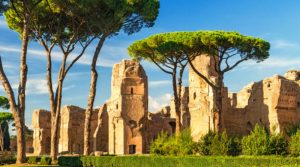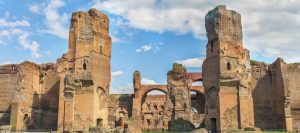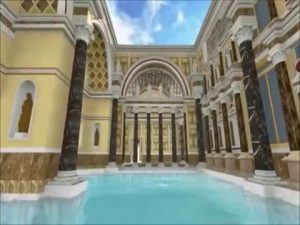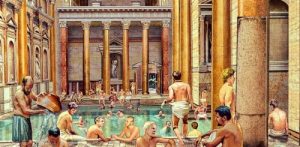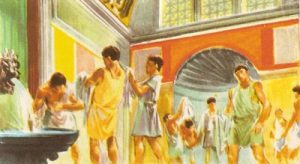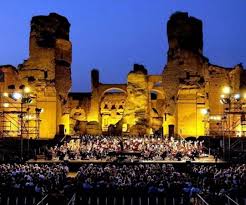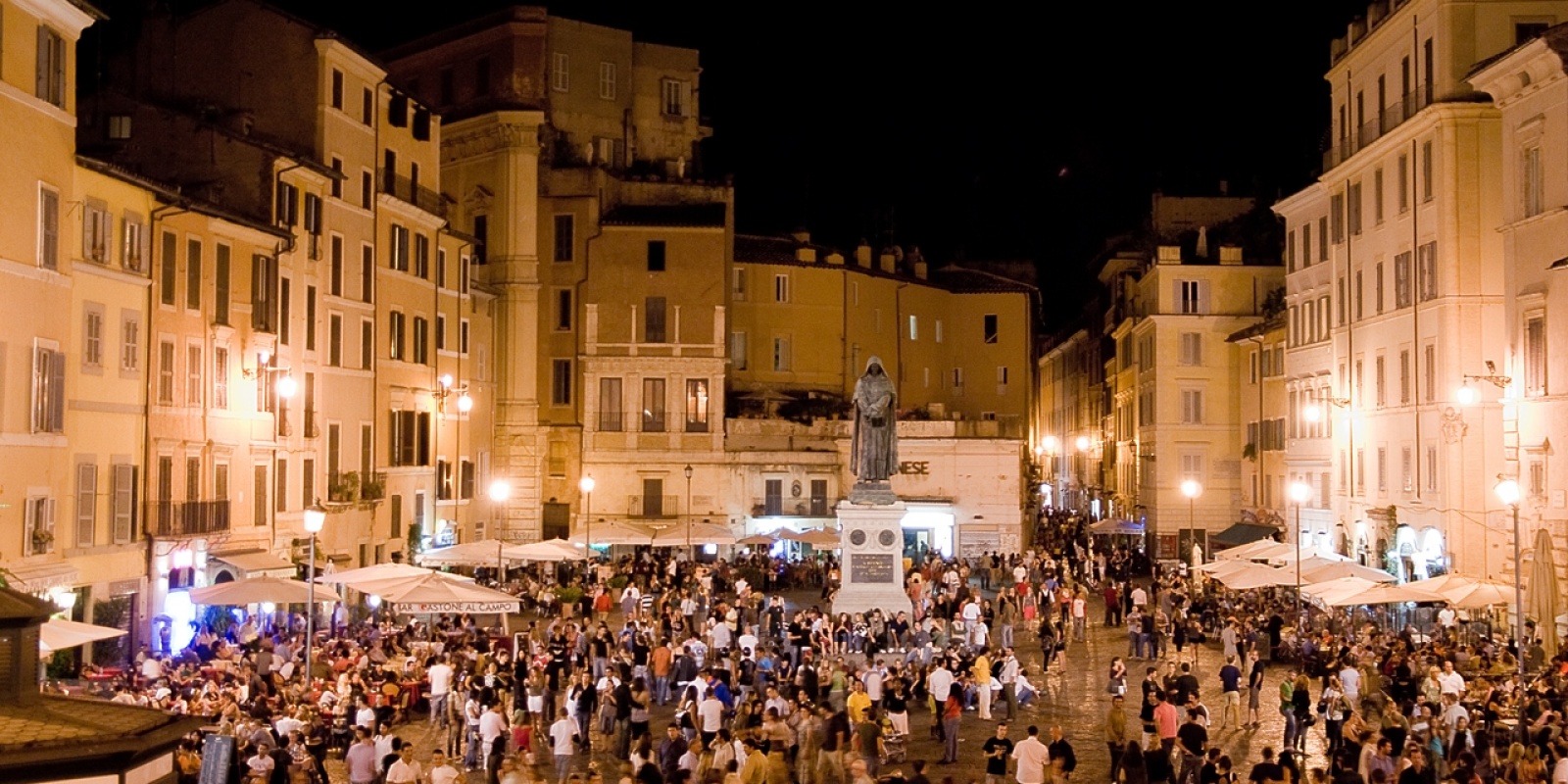Visit the Baths of Caracalla with us
The Baths of Caracalla, located by ancient Appian Way in Rome, were named after the emperor Caracalla (whose official name was Marcus Aurelius Antoninus, hence the original name of the baths, Thermae Antoninianae) who reigned from A.D. 211-217. His father Septimius Severus commissioned the baths and after his death the project was completed by his son Caracalla in 216 A.D.
The emperor was nicknamed Caracalla for a Gallic tunic he used to wear, but this name was never officially used. Caracalla is infamous for killing his more popular brother Geta. He is also known for his decision to offer citizenship to all free inhabitants of the Roman Empire, mainly to increase the income from taxes.
Caracalla’s distant cousin and successor Heliogabalus (218-222) erected the side-buildings, but it was not until the time of Severus Alexander (222-235) that the finishing touches were put on the structure.
The ruins of these baths are enormous and very well preserved with many mosaics still partially intact.
It was the largest bath complex in the world: the central building of the complex is circa 215 by 115 meters and consisted of four levels, two above ground and two below. It is not difficult to be impressed by it even today: the imposing ruins are still thirty meters high.
Beside the bathhouse, the complex was home to shops, an athletic track, sports fields, pleasure gardens, massage rooms, saunas, two reading rooms, perfumeries, music pavilions.
In addition to all of this, one of the side-buildings housed an underground temple to Mithras.
Much of the art that was found on the walls and some mosaic floors have been removed and taken to various museums. The interior of the building was enormously rich in color. The marble walls were littered with paintings and mosaics, the floors were also mosaics and painted sculpture adorned many if not all the alcoves. The structure endorsed 6300m3 of marble and employed 600 marble workers and 6,000 tradesmen to labor on this one project. It is said that before his death Septimius Severus issued 13, 000 prisoners of war from his campaigns to work at Baths building. 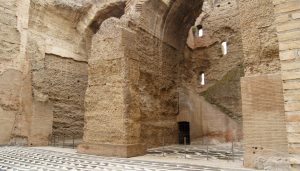
What the baths meant for romans
At a time, when Rome’s crowded tenements had few sanitary facilities, the more than fifty public baths in Imperial Rome played an important part in Roman society. Not only did it improve the cleanliness and health of its citizens, but the thermae were also places where Romans came to socialize, gossip and relax. Like most grand baths, the Baths of Caracalla were about more than just swimming and bathing. It was basically an ancient Roman community center, with wo palaetra (gyms), two libraries (one for Greek texts, one for Latin texts), and plenty of shops.
In their heyday, the Baths of Caracalla could accomodate a staggering 1,600 bathers at a time. In total the baths welcomed between 6,000 and 8,000 visitors each day.
They were fed by a dedicated acquaduct. A complex water distribution system ensured a constant flow of water from the Aqua Marcia aqueduct. Below the main buildings were two levels, the upper one was used for services and heating the water, the lower one was used for water drainage.
The ritual of bathing was a long process, starting with a hot bath in the calidarium. Next up was the lukewarm tepidarium, followed by the cold frigidarium. Then followed a swim in the natatio, an open air swimming pool. The walls and floor of both the tepidarium and calidarium were heated by a system called the hypocaust. The floor was raised and spaces were left between the walls to allow for hot air from a massive furnace to circulate through. In the subterranean structures, hundreds of stokers burned ten tons of wood every day to keep the water at the right temperature. The delivery of fuel was such an important task that Severus Alexander counted it among his personal responsibilities.
The end of the baths
The baths were extremely popular, and remained in use until the sixth century—even the first few waves of barbarian invaders and rulers loved them. The barbarians known as the Ostrogoths, though, not so much. They destroyed the hydraulics and heating systems, and the baths ceased to function in AD 537.
The complex was, as were most ancient structures, subsequently looted over the centuries—you’ve probably seen some of its sculptures without realizing they originally came from here, including the Belvedere Torso, now in the Vatican Museums, and the famous Farnese Bull and Farnese Hercules, both now in the Naples Archological Museum.
Later, the complex was mined for its very stones,which made excellent pre-cut building materials to help construct medieval Rome.
The Bath of Caracalla, excellent location for shows
The Baths of Caracalla are now the site of summertime open-air performances of ballet and opera, including works that employ spectacularly large casts, such as Giuseppe Verdi’s Aida and Georges Bizet’s Carmen. During the summer time, the Caracalla baths turn into a platform for breath taking cultural sets: the fancy Teatro dell’ Opera love to held the most famous operas for all the Roman- and non Roman.
Underground Museum
In December 2012 a museum opened in the tunnels underneath the Baths of Caracalla. The network of tunnels, four kilometers long, was created to service the baths above. The furnaces to heat the hot water baths stood here and the tunnels also served as storage space.
The six-meter-wide tunnels create an atmospheric background for the display of objects that were found on site such as large sculpted capitals, marble reliefs and other ornaments that once decorated the sumptuous bath complex.
Visit Campo de Fiori with us
The square known as Campo de’ Fiori was once a meadow, and, during the Ancient times, it was located between the Pompey’s Theater and the Tiber River.
Because the river was prone to flooding, the area was undeveloped for many centuries.
The piazza as we see today only began to take shape during the fifteenth century, under Pope Callistus III who decided to pave it on 1456, as several important buildings had already been constructed in the area, including the Orsini Palace and the Palazzo della Cancelleria. The Campo de’ Fiori became a very popular part of Rome frequented by the most influential historical figures. Its popularity drew new businesses to the area, opening workshops, inns and taverns making this neighborhood one of the most prosperous of the city.
For centuries public executions took place at Campo de’ Fiori. Criminals and so-called heretics were often tortured and executed here. Many were burned at the stake while others were hanged. One of the more well-known figures executed on this square was the Italian philosopher Giordano Bruno, who in the year 1600 was burned at the stake by the Roman Inquisition because the ideas he spoke of were “dangerous”. The Dominican friar was one of the first to realize that stars are actually suns in the universe. In 1887, sculptor and freemason Ettore Ferrari designed a statue of Bruno. It was placed in the piazza, facing the Vatican as if in defiance of all it stands for. Bruno is now considered an advocate and martyr of the right to free speech.
Today the square is much more peaceful than during the Middle Ages. The Campo de’ Fiori is currently one of the most beloved parts of the city. Since 1869, every morning from Monday through Saturday it houses a market well-known for its flowers and fruit and vegetable. After the sunsets, the area becomes one of the best meeting places in Rome thanks to its wide variety of restaurants, cocktail bars and terraces. There are probably more craft workshops and restorers’ studios, as well as family-run neighbourhood stores, than in any other part of the city.
Campo de’ Fiori is for sure one of the places to visit in Rome
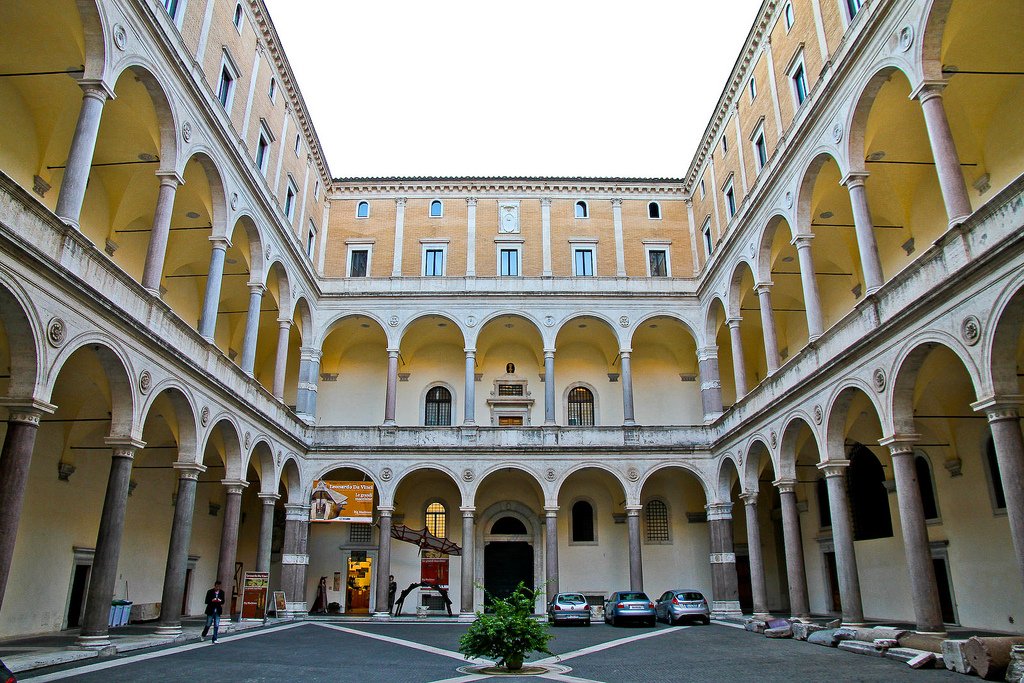
Palazzo della Cancelleria
This building, which is a World Heritage Site and is attributed to Bramante, was once the papal chancery and still belongs to the Holy See. It now houses the Romana Rota, the highest ecclesiastical appeal tribunal of the Roman Catholic church. A permanent exhibition of replicas of many of Leonardo Da Vinci’s machines and designs is open to the public.
Palazzo Farnese
Currently the home of the French embassy to Italy, Palazzo Farnese is one of the most important high Renaissance palaces in Rome. Artists such as Giacomo Della Porta, Michelangelo, da Sangallo and Vignola all left their mark on the majestic palace whose Carracci gallery has recently been restored. Behind Palazzo Farnese runs the quaint Via Giulia. Ivy lined, this road is pleasant to walk down to avoid the noise and crowds while taking in Rome’s elegance. There are many beautiful palazzi with imposing doors and housing expensive antique shops.
Fontana della Terrina
In 1590 a fountain was erected on Campo de’ Fiori to provide the neighborhood with fresh water supplied by a branch of the Aqua Virgo aqueduct. The fountain was designed by Giacomo della Porta. Due to its resemblance to a terrine it later became known as the Fontana della Terrina. At the end of the nineteenth century the fountain had to make way for the monument to Giordano Bruno. In 1925 it was moved to the piazza in front of the Chiesa Nuovo where it still stands today. Around the same time a copy of the fountain was made for the Campo de’ Fiori. The fountain, which occupies a spot on the west side of the square, is almost identical to the original except that this one does not have a lid on it, hence it looks more like a bowl than a terrine.
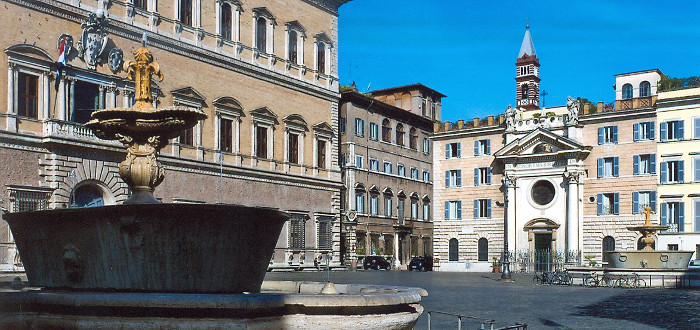
]]>
Visit the Jewish Ghetto with us
The history of Jews in Rome follows all the drastic twists and horrifying turns that have shaped the experience of the Jewish diaspora across the world. Rome has one of the oldest, continually surviving Jewish communities outside the Holy Land. The first ghetto was the Venetian ghetto, formed in 1516, while Rome’s was the world’s second, established in 1555 and its borders were laid down in a Papal Bull along with various discriminatory laws about what professions Jews could and could not hold. The land chosen for Roman ghetto was among the worst in the city. Since the Tiber regularly flooded, the lower parts of the ghetto were regularly underwater. The Jewish Ghetto was walled-in and crowded and life was grim until the Ghetto walls were torn down in 1888.
Jewish culture grew and thrived in the Roman Ghetto, but the neighborhood also witnessed one of the most heart-wrenching episodes of the Nazi occupation during the Second World War. After the German government proclaimed that Rome’s Jews would be spared deportation to the concentration camps if a gold ransom was paid, many in the city, including The Vatican, donated their gold. Even though the Jewish community raised the required amount, Nazi soldiers entered the neighborhood on October 16th, 1943 and deported between 1,000 and 2,000 people. Only 16 survived.
Situated just across from the Tiber Island on the east bank of the river, today the area is a haven of tranquillity in the 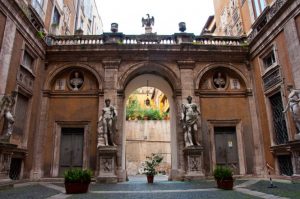 traffic maelstrom that is Rome. Over the years the area has grown into a beautiful neighborhood filled with restaurants, churches, and synagogues that combine jewish culture with the grandeur of Roman architecture. The ruins of the enormous ancient Portico, the Portico d’Ottavia, rise from under 20 feet below street level, at once a testament to history as well as the changes time brings.
traffic maelstrom that is Rome. Over the years the area has grown into a beautiful neighborhood filled with restaurants, churches, and synagogues that combine jewish culture with the grandeur of Roman architecture. The ruins of the enormous ancient Portico, the Portico d’Ottavia, rise from under 20 feet below street level, at once a testament to history as well as the changes time brings.
There are lots of different cool things to do and see – an ancient market and theatre, an impressive synagogue, a lot of tasty restaurants (artichokes!), a postcard perfect fountain and much much more. So, we’ve compiled the following neighborhood bucket list for you to tick off when you visit the Rome Jewish Ghetto.
Teatro Marcello
Named after Marcus Marcellus, Emperor Augustus’s nephew, who died five years before its completion, the Teatro was begun by Julius Caesar and completed by Augustus in 13 BC. It’s also known as the Jewish Coliseum for its resemblance to the original Colosseum. This ancient, open-air theater once held approximately 11,000 to 20,000 spectators, and the seats filled for acting, dancing or singing performances. Today it still holds different shows throughout the summer.
The Great Synagogue
The Great Synagogue of Rome, or the Tempio Maggiore di Romain Italian, is the largest synagogue in all of Rome and possibly all of
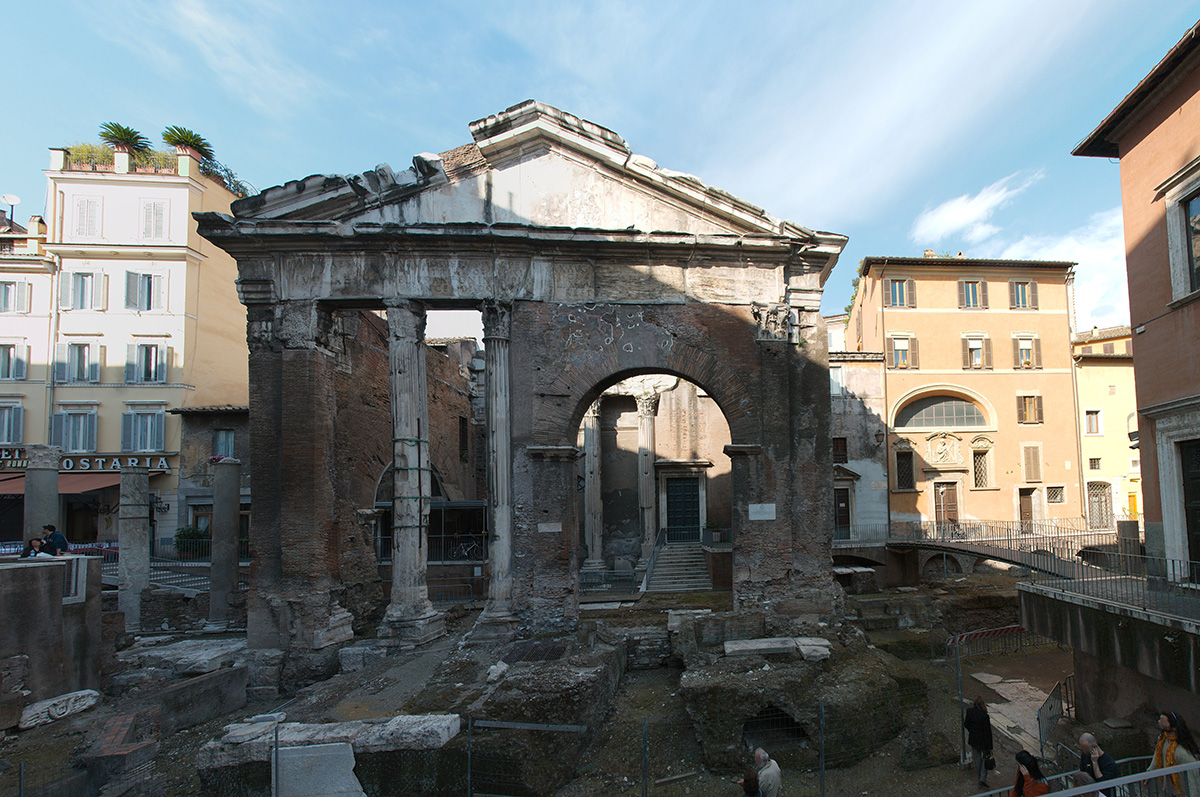
Italy. This impressive building is pretty new by Roman standards. After people of Jewish faith were granted citizenship during Italian unification in 1870, the original ghetto synagogue was torn down and plans for the Great Synagogue began. The cornerstone was laid in 1901 and the Synagogue was officially completed in 1904, a veritable baby in the Roman skyline.
Jewish Museum of Rome
The Jewish Museum is located in the Great Synagogue. Opened underneath the Great Synagogue in 1960, it displays silverware and textiles, parchments and marble carvings from the collections of the Jewish Community of Rome. It tells the history of the Jews and the Jewish G
hetto in Rome.
The Fontane delle Tartarughe
The Turtle Fountain is a late Renaissance fountain. Though it might have been called the Dolphin Fountain, as it once had dolphins where the turtles now sit, they were removed because of low water pressure, and the turtles were added to make the fountain seem complete. Originally built as a drinking fountain, the water was sourced from the Acqua Vergine, one of Rome’s first aqueducts – a big deal for sixth century Romans!
]]>
